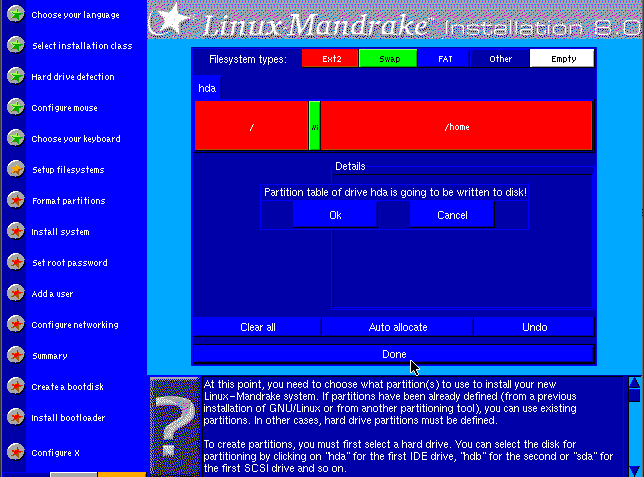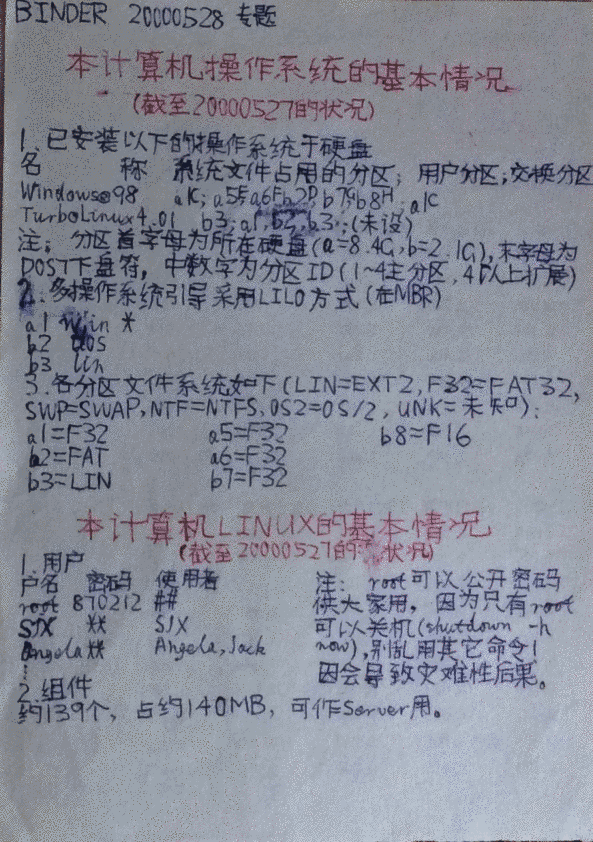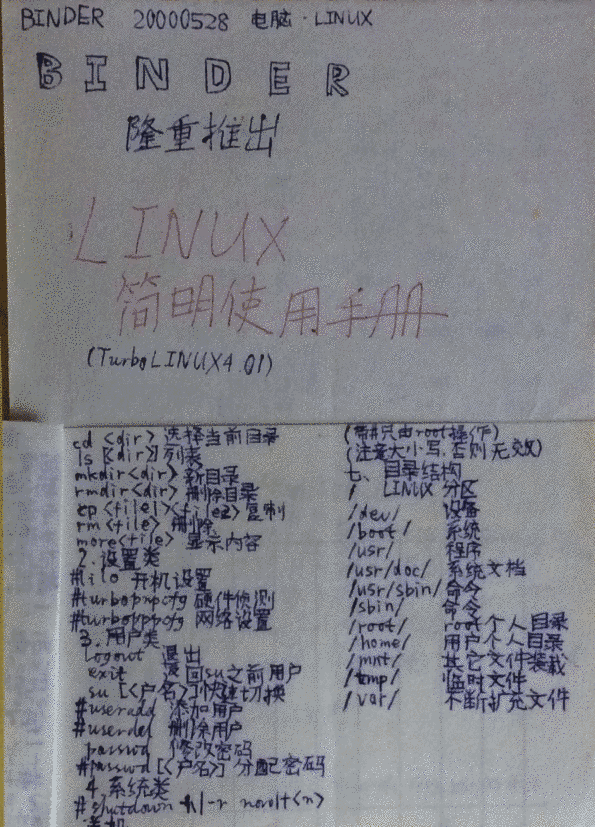Which was the fist Linux Distro you tried?
Folks,
Thought of asking- inspired from the KDE discussion in the Cest Pit…
Which was the first Linux Distro you tried? What details do you recall ?
(Or BSD, or..)
For example
Year, version, device/hardware, etc..?
What was your first reaction or experience using Linux ? And finally,
What Distro do you use circa 2021?
Any pictures to share would be awesome.
——
My first distro was in early to mid 2001 Red Hat 6.2 Zoot. A friend in grad school set up dual boot on my Sony Vaio that had Windows Me.

Image source: random internet search.
I was quite impressed, untill… a series of Kernel Panics prompted my friend to install Mandrake KDE. Two days later, the laptop produced a sharp, tinny noise in the middle of a class. And it would not stop. I had to remove the battery and do a system restore after wards.

Image: wikipedia
Not the greatest of memories, but had all gone smoothly, I would never have stayed with the OS.
In 2021 I use Solus KDE on Macbook Pro 2015, Linux Mint on standby laptop and Ubuntu Mate on Raspberry Pi 4. Have tried about one third of the distros listed on Distrowatch till 2020.
Happy Friday!



Comments
Redhat on a 486 I think. Didn't get particularly far with it in the desktop context. Couple years later I did use it for a half year stint as desktop OS though.
Linux in virtualization / server context has been better. Mostly using debian.
Gonna have another desktop go at it via guac though...thinking Arch
Yes, I'm old. The first some I used Linux was Centos 7. First time I used it was 2017!
First distro ever touched (at a friend's house): unsure, but probably Slackware or Debian, around 1998 (don't remember much, other than it was terribly slow, as the hardware was most likely 486; it also had a rather interesting GUI, )
First distro used personally (on an self-owned PC): Ubuntu 6 (it felt safer than Windows, perhaps not fully rightfully so as later on I did learn that Linux has its own share of viruses lol...other than that, at the time I was a light user, barely touching the command line; other than the lack of MS Office, in general I think it felt not as user friendly, e.g. I think I had to install codecs separately in order to be able to play videos... also Flash support wasn't as good as the one on Windows AFAIR)
Distros used now: Lubuntu 20.10 (home PC; the desktop seems to be somewhat unstable, will probably go back to Xubuntu soon), Ubuntu+XFCE 20.04 (RDP jumpbox), Ubuntu 20.04 (new servers@work), CentOS 7/RHEL 7 (old servers@work)
Contribute your idling VPS/dedi (link), Android (link) or iOS (link) devices to medical research
Suse Linux 1.0.9. That was around 1994 and quite a horrible user experience. It took me days to install it and the thing was not even running properly afterwards. I love Debian today for everything server related, but back in the days, Linux scared the shit out of me.
Amitz, a very stable genius (it's true!) and Grand Rectumfier of the official LESLOS® (LES League of Shitposters).
Certified braindead since 1974 and still perfectly happy.
If memory serves it was Slackware .. I think 0.9 ( yes, below 1.0 ). Pretty sure I still have at least some of the disks if they haven't succumbed to bit rot. This would've been early ninety's. I needed a way to do my CompSci homework that didn't require me to sit in the lab for hours at a time. "No food or drinks in the lab". "No singing along to your walkman in the lab". "You have to wear pants while in the lab". #FunPolice. Well, and we tended to get distracted playing xPilot and xtank. A quick SLIP in to the uni dial-up banks though and I could be coding any time I wanted. Those were the days ...
I was just cleaning out my CD-s a week ago and had one with Ubuntu 8.04 - It's either that or some version of suse
I'm the 85%. Also Elon likes memes hence he's an idiot.
SUSE Linux from a CD-ROM attached to a magazine. Downloading an OS wasn’t really a thing when your internet was billed by time. First impression? Well, dual-boot turned out to be single-boot in the end, so let’s say not so great at all. 😄
— Michael
Alwyzon - Virtual Servers in Austria starting at 4,49 €/month (excl. VAT)
Linux FT v1.2, came on a couple of floppies with a magazine. Then later Slackware, then RedHat and then Debian ...
Then later Slackware, then RedHat and then Debian ...
In 2000-May, I installed TurboLinux 4.01 on the family computer.
The installation CD comes from 《PC任我行》 (PCDIY) magazine that I subscribed to.
I spent lots of time figuring out LILO to make it boot Windows 98 by default.
I didn't get beyond playing simple games and looking at the analog clock.
These are the announcements I made in the "family newspaper", i.e. a stack of handwritten notes hanging on the wall, which includes passwords and basic linux commands.


Webhosting24 aff best VPS; ServerFactory aff best VDS; Cloudie best ASN; Huel aff best brotein.
@yoursunny Your Linux ads in the family newspaper are amazing!
My first Linux was SUSE. Back in the day, one could go to the store to buy a Linux CD. The store I visited sold the SUSE CD in a box together with a free book.
There was another distro also being sold -- I don't remember which -- SUSE was the same price as the other distro's CD, which didn't include a book.
I thought SUSE was a better deal. The book was helpful! I managed to get everything set up, except that I couldn't get the printer working.
I attended the Computer Society's $100 installfest. I figured they could get the printer working, but they couldn't.
MetalVPS
Red Hat Linux
Ubuntu 12.04
RedHat 6 (I think) from a magazine while I was in last few years of school.
Didn't get on with it and a few other friends who'd tried the same CD had switched and were trying Debian - so I installed Slackware.
Ran just Slackware for a few years, even on my primary laptop when I got one (think it was a Dell - I know it had a PCMCIA wifi card)
I eventually tried Debian to see what all this "no-compiling-from-source-just-apt-get-it" was about as faster internet became more popular and have used it for a lot of things.
MY desktop runs Debian 10 with Mate desktop. I still go for Slackware for something lightweight, or OpenBSD too.
I used Debian as my first distribution, I don't remember the version. I also tried RedHat, Slackware, and Suse. My desktops and laptops have been through Debian, Ubuntu, and most recently Linux Mint.
CentOS 7 on a openVZ VPS. Forgot the provider name. It was 2015 I guess. I chose CentOS because of cPanel supported it, I didn't know much about Linux & I had to run a website that was running on a shared hosting & they suspended the hosting because of high load.
Now my primary choice is Debian for running stuff & Ubuntu for testing purposes as packages are updated compared to Debian.
A 'modified' fork of RedHat on a Cobalt RaQ 4 early 2000's. A steep learning curve coming from a Windows NT background as nearly everything off the beaten track then needed to be compiled from source without upsetting the core system and admin panel, and it was a live platform, albeit an experimental one for the company. Retrospectively installed vanilla RedHat on some old Pentium PC as a development testbed.
Kind of put me off web panel admin systems on Linux for life. Though not Linux itself, these days stick with Debian managed via SSH/Ansible for production, and rarely touch Windows systems at all.
I've got a RaQ 4r, still works. Got the original OS/etc on it.
Yeah they were pretty robust boxes. Hope yours doesn't connect to the Internet these days though, they had quite a few exploits to keep on top of and patch IIRC.
Mandrake, back in '99 OR 2001, I don't remember quite.
After that went on to try Slackware, Red Hat and FreeBSD (not necessarily in that order), before settling in nicely with Debian which is where I've stayed since.
I'm not sure to be honest. i messed around with a few different distros in the 199x years. Most of that stuff came in the form of cd or floppy. Sourced either from friends or some "magazines" that would also bundle linux distro/install cd/media.
★ MyRoot.PW ★ Dedicated Servers ★ LIR-Services ★ Web-Hosting ★
★ Locations: Austria + Netherlands + USA ★ [email protected] ★
No, I don't power it up often.
Just did out of curiosity and
sshis timing out while trying to connect. That's annoying.My first one was probably DSL because it was one of the easiest to get on dialup. The downside was missing out on some of the more useful applications available in other distros out of the box, but it was also the most reliable distro that could boot on my half-broken laptop (at least among a few I had put on CDs) at the time.
Nice. I still have an Ubuntu 7.04 CD from when they used to mail out CDs on request and their slogan was "linux for human beings" (whatever that means now with robots and AI).
@yoursunny if i may ask - How old are you?
Ubuntu 6.10 (Edgy Eft)
Slackware, can't remember if it was 4 or 6 floppy disks to install from.
All I remember is that one was broken (bad sectors) and I had to take my bike over to a friend's house to copy that floppy so I could finish the installation.
And before you ask, the Internet wasn't that big at that time. We used to download our stuff from BBS with our 300 baud modems.
https://clients.mrvm.net
Mandrake 9.2 on an old E-Machines.
LaunchVPS, LLC - Performance Optimized VPS, Web Hosting, and Reseller Plans
ZFS-Backed SSDs | KVM | LXC | cPanel | AS397384 | 99.9% Uptime | Any OS | PHL USA DC | 45-Day Money Back Guarantee
Knoppix, i forgot the version, but around 2005
| Psikolog Jogja | Biro Psikologi Jogja |
I think i tried slackware from pcquest mag free cd (around 1999).
My reliable providers : Ramnode : HostHatch : Serverica : InceptionHosting : AlphaVps : LittleCreekHosting : NexusBytes : Hostodo
It's kinda har finding info on Linux-FT these days. Using Wayback Machine I was able to figure out that Lasermoon released 2.0 in 97, so I'm not sure when 1.2 was released.
They were very proud of it being Posix certified. I think I switched to Slackware 2.x after this.
And a while later I ordered Slackware 95 (= 4.0?) on CD.
Maybe someone would like this old article about Linux-FT:
https://www.ukuug.org/newsletter/linux-newsletter/linux@uk21/posix.shtml
Ah, printing under Linux -- this topic has a long and somewhat tortured history. The torture largely stemmed (and still stems) from cheap GDI (Graphics Device Interface) printers (a.k.a. "Winprinters") that beginners innocently purchased and then thought that they would work under Linux, and when the printers didn't work, it was earlier to blame Linux than to blame the Winprinters (which worked under Windows after all). The problem with Winprinters was (and still is) that all of the print processing was done on a host computer running Windows using GDI -- the Winprinters themselves were remarkably dumb.
When I began to learn Linux, I quickly became aware of Winprinters and wanted to avoid them at any cost. I remember studying (an earlier version of) The Printing HOWTO ( https://tldp.org/HOWTO/Printing-HOWTO/ ), which is still a useful document (although a bit dated now). I decided that the best strategy for the longer term was to buy a PostScript printer, but new PostScript printers were expensive in those days. I then looked on eBay and found locally an Apple LaserWriter Select 310 ( https://lowendmac.com/1993/laserwriter-select-310/ ) in good condition for a nice price. (The printer weighed 26 pounds, so shipping it was out of the question!) I added more RAM to the printer because the 1.5MB RAM that it was shipped with was the bare minimum and often not enough to render a page in PostScript. The good news was that Linux worked out of the box with this printer (and continued to work with this printer long after later versions of Mac OS had abandoned it).
In retrospect, the Apple LaserWriter Select 310 wasn't the best choice of PostScript printer, because it supported only PostScript Level 1, whereas PostScript Level 2 quickly became the standard. This meant that I needed to make sure that I sent the printer only PostScript Level 1 code, but this increasingly became a nuisance because most drivers produced PostScript Level 2 code. The other issue was that the Apple toner cartridges for this printer were expensive (and there were no third-party alternatives that I was aware of).
My next PostScript printer was an HP LaserJet 6MP ( https://www.openprinting.org/printer/HP/HP-LaserJet_6MP ), also purchased in good condition on eBay, which supported both PCL 6 (HP's own page description language) and PostScript Level 2. This printer was a huge upgrade from the Apple LaserWriter Select 310, most noticeably in terms of RAM and of speed, not to mention that reasonably priced third-party toner cartridges were easy to find for this printer. Needless to say, after getting the HP LaserJet 6MP, I never looked back at the Apple LaserWriter Select 310 (whose engine simply died at some point).
As for my very first Linux distribution, I'll keep it short: it was Debian 2.1 (Slink), accompanied by the excellent Learning Debian GNU/Linux by Bill McCarty ( https://www.oreilly.com/openbook/debian/book/ ).
"A single swap file or partition may be up to 128 MB in size. [...] [I]f you need 256 MB of swap, you can create two 128-MB swap partitions." (M. Welsh & L. Kaufman, Running Linux, 2e, 1996, p. 49)